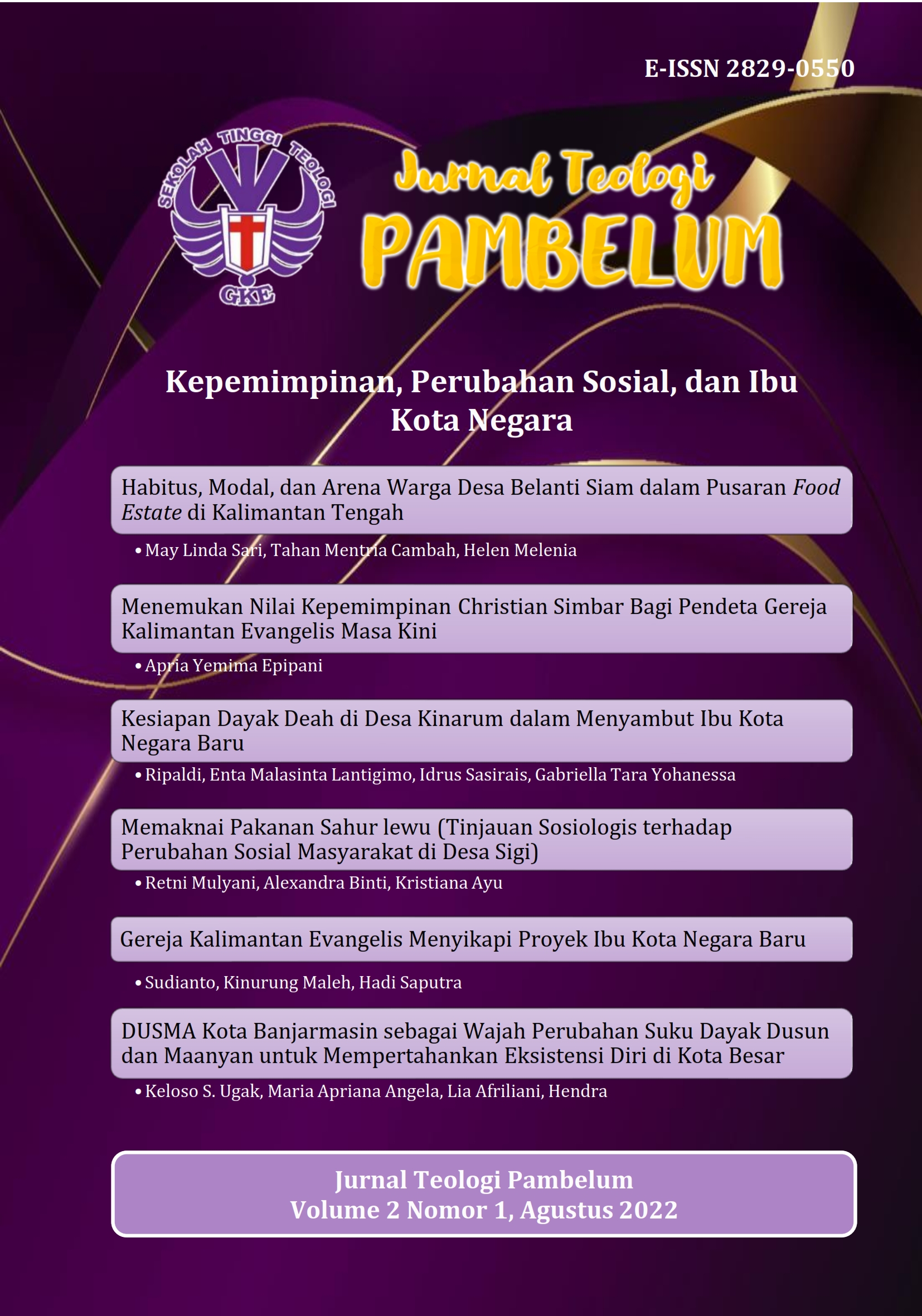Habitus, Modal, dan Arena Warga Desa Belanti Siam dalam pusaran Food Estate
DOI:
https://doi.org/10.59002/jtp.v2i2.29Abstract
Since 2019, the government has implemented a national program to build a national-scale food barn known as the Food Estate. This food estate area is being developed in the provinces of North Sumatra and Central Kalimantan. Substantially, the purpose of this food estate program is very large, namely to become a place for the development of food diversification and extensification that will ensure the availability of food to meet the needs of the community for a long time and is sustainable. In Central Kalimantan province, food estate is being developed in two districts, namely Pulang Pisau and Kapuas districts. Of course, this program is expected to bring satisfactory results as expected. Not only that but it is also expected to have an impact on the lives of the people living in the program area. One of the interesting areas to study is Belanti Siam village, Pandih Batu sub-district, Pulang Pisau district, and Central Kalimantan. In this area, most of the population has been sucked into farmer groups who are developing hybrid rice cultivation and have also enjoyed the harvest through the food estate program. This study is an attempt to examine the extent to which this program has a social and cultural impact on the Belanti Siam village community. The research was carried out from February-June 2022 using a qualitative method. The data were then analyzed using Bourdieu's theory of social practice theory, resulting in 3 research findings, namely: first, the Belanti Siam village community experienced social and economic changes in the form of capacity building and quality of life. Second, the food estate has a positive impact on the social life of the local community, especially in the economic sector and improving road infrastructure. And third, the community still maintains the values of local wisdom in terms of planting and harvesting.
References
Adiyanto, A. (t.t.). Habitus dan Praktik Aktor dalam Arena Pemajuan Kebudayaan | EndNote Click. Diambil 18 Juni 2022, dari https://click.endnote.com/viewer?doi=10.20473%2Fbk.v10i1.27799&token=WzM1NTg0MjQsIjEwLjIwNDczL2JrLnYxMGkxLjI3Nzk5Il0.do1rifaw-mKuYin4m4FunnVkCdE
Ariyani, N. I., Demartoto, A., & Zuber, A. (2018). HABITUS PENGEMBANGAN DESA WISATA KUWU: STUDI KASUS DESA WISATA KUWU KECAMATAN KRADENAN KABUPATEN GROBOGAN. Jurnal Analisa Sosiologi, 4(2). https://doi.org/10.20961/jas.v4i2.17436
Bayu Aditya (Direktur). (2019, September 11). ANIMASI USULAN DESAIN WISATA PADI DESA BELANTI SIAM. https://www.youtube.com/watch?v=lryfXk32ff0
BILIK INSIDER (Direktur). (2019, September 19). KAPITAL/MODAL - PIERRE BOURDIEU. https://www.youtube.com/watch?v=hv8HOOEYPdc
Bourdieu, P. (1979). Symbolic Power. Critique of Anthropology, 4(13–14), 77–85. https://doi.org/10.1177/0308275X7900401307
Bourdieu, P. (2019). Pierre Bourdie Habitus and Field: General Sociology, Volume 2 (Vol. 2). Polity Press.
Bourdieu, P., & Novenanto, A. (2018). Habitus: Sebuah Perasaan atas Tempat. Jurnal Kajian Ruang Sosial-Budaya, 2(1), 153–159. https://jkrsb.ub.ac.id/index.php/jkrsb/article/view/27
Chasan, M. (2020). Peran kelompok tani dalam meningkatkan kesejahteraan masyarakat di Desa Belanti Siam Kabupaten Pulang Pisau [Undergraduate, IAIN Palangka Raya]. http://digilib.iain-palangkaraya.ac.id/2979/
Eks-PLG, REDD+ Gandeng PNPM di Pulang Pisau—Direktorat Jenderal Pengendalian Perubahan Iklim. (t.t.). Diambil 26 Agustus 2022, dari http://ditjenppi.menlhk.go.id/dari-media/306-eks-plg-redd-gandeng-pnpm.html
Food Estate: Pangan Melimpah, Harga Lebih Murah | Indonesia Baik. (t.t.). Diambil 26 Agustus 2022, dari https://indonesiabaik.id/infografis/food-estate
Geertz, C. (2014). Agama Jawa: Abangan, Santri, Priyayi dalam Kebudayaan Jawa (2 ed.). Komunitas Bambu.
Grenfell, M. (2008). Pierre Bourdieu Key Conceps. Acumen Publishing Limited.
Harrits, G. S. (2011). Political power as symbolic capital and symbolic violence. Journal of Political Power, 4(2), 237–258. https://doi.org/10.1080/2158379X.2011.589178
JURNAL TELEVISI (Direktur). (2020, September 14). PETANI MILENIAL DESA BELANTI SIAM DUKUNG SUGIANTO EDY. https://www.youtube.com/watch?v=Eb-YGA1CLYo
Krisdinanto, N. (2014). PIERRE BOURDIEU, SANG JURU DAMAI: Kanal: Jurnal Ilmu Komunikasi, 2(2), 189–206. https://doi.org/10.21070/kanal.v2i2.300
PEKAT JULI: Apa Itu Food Estate? – kab.faperta.ugm.ac.id. (t.t.). Diambil 26 Agustus 2022, dari https://kab.faperta.ugm.ac.id/2021/07/29/pekat-juli-apa-itu-food-estate/
Sudia, & Hadikir. (2022, Maret 29). Pengambilan Keuputusan Kegiatan Desa (bagian 1) [Komunikasi pribadi].
Sulvianus, A., Ryan, & Jerri. (2022, Juni 1). Tarkam Desa Belanti Siam [Komunikasi pribadi].
Sutarianto. (2022, Juni 1). Pengambillan keputusan kegiatan desa [Komunikasi pribadi].
Tariman. (2022a, Juni 1). Akses ke desa Belanti Siam [Komunikasi pribadi].
Tariman. (2022b, Juni 1). Penggilingn Padi [Komunikasi pribadi].
Tariman. (2022c, Juni 1). Pupuk di Desa Belanti Siam [Komunikasi pribadi].
Downloads
Published
How to Cite
Issue
Section
License
Copyright (c) 2022 May Linda Sari, Tahan M. Cambah, helen melenia

This work is licensed under a Creative Commons Attribution 4.0 International License.













